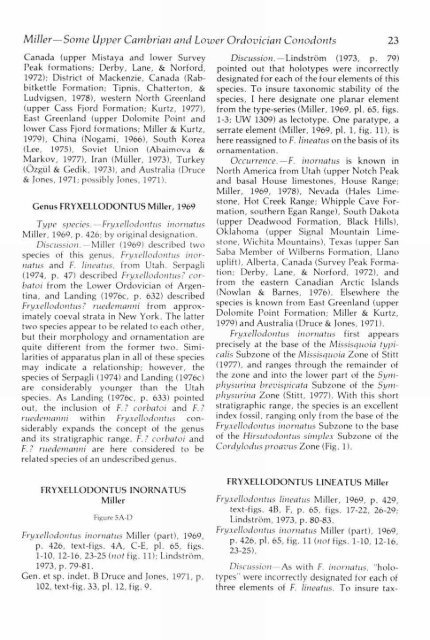View - KU ScholarWorks - University of Kansas
View - KU ScholarWorks - University of Kansas
View - KU ScholarWorks - University of Kansas
You also want an ePaper? Increase the reach of your titles
YUMPU automatically turns print PDFs into web optimized ePapers that Google loves.
Miller-Some Upper Cambrian and Lower Ordovician Conodonts 23<br />
Canada (upper Mistaya and lower Survey<br />
Peak formations; Derby, Lane, & Norford,<br />
1972); District <strong>of</strong> Mackenzie, Canada (Rabbitkettle<br />
Formation; Tipnis, Chatterton, &<br />
Ludvigsen, 1978), western North Greenland<br />
(upper Cass Fjord Formation; Kurtz, 1977),<br />
East Greenland (upper Dolomite Point and<br />
lower Cass Fjord formations; Miller & Kurtz,<br />
1979), China (Nogami, 1966), South Korea<br />
(Lee, 1975), Soviet Union (Abaimova &<br />
Markov, 1977), Iran (Muller, 1973), Turkey<br />
& Gedik, 1973), and Australia (Druce<br />
& Jones, 1971; possibly Jones, 1971).<br />
Genus FRYXELLODONTUS Miller, 1969<br />
Type species. - Fryxellodontus inornatus<br />
Miller, 1969, p. 426; by original designation.<br />
Discussion. -Miller (1969) described two<br />
species <strong>of</strong> this genus, Fryxellodontus inorflatus<br />
and F. lineatus, from Utah. Serpagli<br />
(1974, p. 47) described Fryxellodontus? corbatoi<br />
from the Lower Ordovician <strong>of</strong> Argentina,<br />
and Landing (1976c, p. 632) described<br />
Fryxellodontus? ruedemanni from approximately<br />
coeval strata in New York. The latter<br />
two species appear to be related to each other,<br />
but their morphology and ornamentation are<br />
quite different from the former two. Similarities<br />
<strong>of</strong> apparatus plan in all <strong>of</strong> these species<br />
may indicate a relationship; however, the<br />
species <strong>of</strong> Serpagli (1974) and Landing (1976c)<br />
are considerably younger than the Utah<br />
species. As Landing (1976c, p. 633) pointed<br />
out, the inclusion <strong>of</strong> F.? corbatoi and F.?<br />
ruedemanm wit hi n Fryxellodon tus considerably<br />
expands the concept <strong>of</strong> the genus<br />
and its stratigraphic range. F.? corbatoi and<br />
F.? ruedemanni are here considered to be<br />
related species <strong>of</strong> an undescribed genus.<br />
Discussion. -Lindstrôm (1973, p. 79)<br />
pointed out that holotypes were incorrectly<br />
designated for each <strong>of</strong> the four elements <strong>of</strong> this<br />
species. To insure taxonomic stability <strong>of</strong> the<br />
species, I here designate one planar element<br />
from the type-series (Miller, 1969, pl. 65, figs.<br />
1-3; UW 1309) as lectotype. One paratype, a<br />
serrate element (Miller, 1969, pl. 1, fig. 11), is<br />
here reassigned to F. lineatus on the basis <strong>of</strong> its<br />
ornamentation.<br />
Occurrence.- F. inornatus is known in<br />
North America from Utah (upper Notch Peak<br />
and basal House limestones, House Range;<br />
Miller, 1969, 1978), Nevada (Hales Limestone,<br />
Hot Creek Range; Whipple Cave Formation,<br />
southern Egan Range), South Dakota<br />
(upper Deadwood Formation, Black Hills),<br />
Oklahoma (upper Signal Mountain Limestone,<br />
Wichita Mountains), Texas (upper San<br />
Saba Member <strong>of</strong> Wilberns Formation, Llano<br />
uplift), Alberta, Canada (Survey Peak Formation;<br />
Derby, Lane, & Norford, 1972), and<br />
from the eastern Canadian Arctic Islands<br />
(Nowlan & Barnes, 1976). Elsewhere the<br />
species is known from East Greenland (upper<br />
Dolomite Point Formation; Miller & Kurtz,<br />
1979) and Australia (Druce & Jones, 1971).<br />
Fryxellodontus Mornatus first appears<br />
precisely at the base <strong>of</strong> the Missisquoia typicalis<br />
Subzone <strong>of</strong> the Missisquoia Zone <strong>of</strong> Stitt<br />
(1977), and ranges through the remainder <strong>of</strong><br />
the zone and into the lower part <strong>of</strong> the Sympbysurina<br />
brevispicata Subzone <strong>of</strong> the Symphysurina<br />
Zone (Stitt, 1977). With this short<br />
stratigraphic range, the species is an excellent<br />
index fossil, ranging only from the base <strong>of</strong> the<br />
Fryxelloclontus inornatus Subzone to the base<br />
<strong>of</strong> the Hirsutodontus simplex Subzone <strong>of</strong> the<br />
Cordylodus proavus Zone (Fig. 1).<br />
FRYXELLODONTUS INORNATUS<br />
Miller<br />
Figure 5A-I)<br />
Fryxellodontus inornatus Miller (part), 1969,<br />
p. 426, text-figs. 4A, C-E, pl. 65, figs.<br />
1-10, 12-16, 23-25 (not fig. 11); Lindstr6m,<br />
1973, p. 79-81.<br />
Gen. et sp. indet. B Druce and Jones, 1971, p.<br />
102, text-fig. 33, pl. 12, fig. 9.<br />
FRYXELLODONTUS LINEATUS Miller<br />
Fryxellodontus !Meatus Miller, 1969, p. 429,<br />
text-figs. 4B, F, p. 65, figs. 17-22, 26-29;<br />
Lindstrôm, 1973, p. 80-83.<br />
Fryxellodontus inornatus Miller (part), 1969,<br />
p. 426, pl. 65, fig. 11 (not figs. 1-10, 12-16,<br />
23-25).<br />
Discussion-As with F. inornatus, "holotypes"<br />
were incorrectly designated for each ot<br />
three elements <strong>of</strong> F. 'Meatus. To insure tax-
















